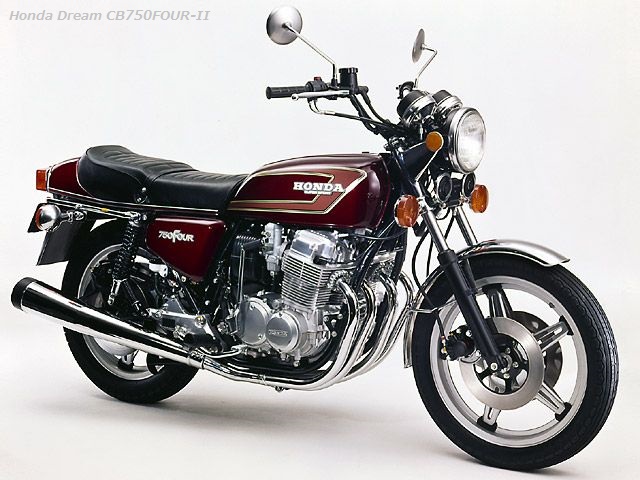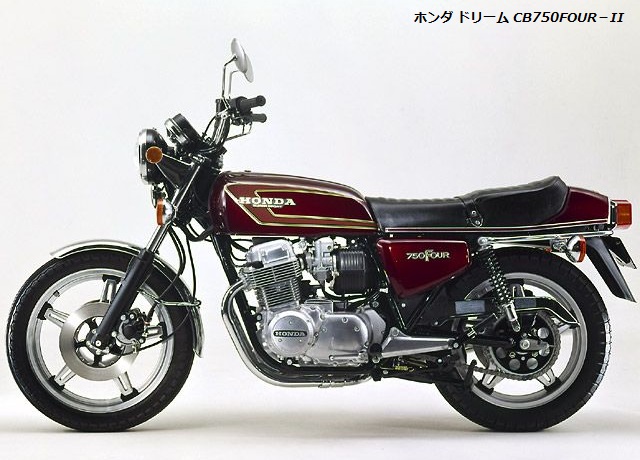Honda CB750FOUR-II 1975-1977
1995-1997 Honda Dream CB750FOUR-2 Specs, Features & Photos Gallery
 |
| [ホンダ ドリーム CB750FOUR-II] model year 1975-06-24. Body colour: yellow. |
Announced and released on June 24, 1975. Model name Honda Dream CB750 FOUR-II. A a quiet and comfortable long touring vehicle, derivative model that incorporates a cafe racer style added in the form of being sold together with the CB750FOUR. Equipped with a 4-into-1 set type muffler, rear wheel single disc brake, seat cowl with accessory compartment, and other exterior changes such as larger tail lamps and turn signals in consideration of safety.
As the top model of the Honda 4-cylinder series, this car adopts a collective exhaust system that brings a quiet exhaust sound to a tenacious engine. It is the first motorcycle in Japan to be equipped with hydraulic disc brakes that consistently exert a stable braking force on the front and rear wheels.
The CB750 Four-2 that appeared in 1975 as a new model following the CB750 Four (1969-) equipped with the world's first inline 4-cylinder engine. It was the first domestic model to adopt hydraulic disc brakes on both the front and rear wheels. In addition, the four-pipe muffler, which was characteristic of the CB750 fore, adopted the 4into1 "collective exhaust" system, which later became a general specification. In 1977, minor changes were made to the double-disc front brakes.
 |
| 1977 Honda Dream Honda CB750FOUR-II photo. A classic bike restoration idea. |
Announced on April 21, 1977, the following minor changes were made on sale on the 22nd of the same month.
- From the viewpoint of maintenance-free, the spoke wheels have been changed to our own assembled Comstar wheels.
- Double front disc brakes. The caliper is newly designed and moved to the rear of the fork.
- By reviewing the engine characteristics, the maximum output is 65ps/8,500rpm and the maximum torque is 5.9kg-m/7,500rpm.
Honda Dream CB750FOUR-II Main Features
- Equipped with a 4-cycle 736cc 4-cylinder 67-horsepower dry sump engine. The adoption of a unique collective exhaust pipe provides a quiet and comfortable exhaust sound and torque characteristics that are particularly useful in the medium speed range.
- The long wheelbase, proper weight distribution, and optimal alignment and suspension matching ensure excellent maneuverability and stability.
- The design from the tank and seat to the tail end forms a slim and sophisticated flow line.
Honda CB750FOUR-II Release date
June 24, 1975
Honda CB750FOUR-II Price
468,000 yen
(national standard cash price).
Monthly production plan: 6,000 units
(including exports)
 |
| 1977 Honda CB750 FOUR-II picture. Old bigbig with 4-cylinder 750cc engine. |
Honda CB750FOUR-II Engine related
- 1. Equipped with a closed ratio 5-speed transmission that makes effective use of the power of the 67-horsepower OHC engine, which has a reputation for reliability. The final reduction ratio has been increased, and the 4th and 5th gears have been particularly closed, resulting in easy handling and smooth driving performance.
- 2. The large-capacity air cleaner is newly designed with measures against transmitted sound. Low inhalation resistance and quiet inhalation noise. A collective exhaust system with four exhaust pipes integrated into one muffler has been adopted to achieve an extremely quiet exhaust sound. Exhaust gases from the four cylinders are collected in a large volume collecting chamber. While each cylinder explodes in sequence, it accelerates the exhaust of other cylinders and enhances the pulsation effect, thereby obtaining good engine characteristics and enhancing the noise reduction effect.
- 3. Equipped with an idle limiter to prevent an increase in CO emissions in the exhaust gas. In addition, the blow-by gas reduction device to prevent HC emissions is equipped with a newly designed breather oil catch tank that removes oil to prevent deterioration of the element.
(Note) This breather oil catch tank is based on the principle of a cyclone, which separates the blow-by gas from the engine into liquid and gas by centrifugal force, and only the gas is guided to the carburetor for re-combustion. - 4. A new mechanism throttle linkage has been adopted to reduce wrist fatigue and prevent fatigue during long touring.
Honda CB750FOUR-II Frames
- 1. The frame is a highly rigid and lightweight full double cradle type. The combination of a front fork that can withstand lateral loads, a long rear fork, and large-capacity front and rear dampers provides excellent maneuverability and ride comfort at all speeds. In addition, the softer front cushion, alignment, suspension, and appropriate weight distribution settings have resulted in stable straight running and excellent maneuverability.
| Front cushion damping force | TEN. 40Kg/0.5m/S COMP. 15Kg/1.0m/S |
| Rear cushion damping force | TEN. 120Kg/0.5m/S COMP. 30Kg/1.0m/S |
| Front fork offset | 50m/m |
| Caster angle | 61°10' |
| Trail | 119m/m |
| Wheelbase | 1,470m/m |
| Front/rear weight distribution | Front axle 113Kg Rear axle 131Kg |
- 2. The fuel tank cap is a completely embedded flat type covered with a black painted lid. The cap has a chain to prevent it from being lost, and a new mechanism to prevent the lid from being locked unless the cap is completely tightened, as well as a fuel overflow pipe. The lid is opened and closed with the main key.
Consideration for ease of handling and safety
- 1. Adoption of disc brakes for the rear wheels for the first time in Japan. The diameter of the front wheel disc piston has also been increased to increase braking power. In addition, both the front and rear pads are made of new material and have excellent water resistance. The wear check scale on the rear wheel disc pad is a window type that prevents water and mud and makes inspection easier.
- 2. Hard rubber is attached to the tip of the arm so that even if you forget to put the side stand back when you start moving, it will automatically retract while absorbing the shock caused by the road contact.
- 3. Main stand Since the fulcrum of the main stand is changed by enlarging the contact surface, it can be set with a light force.
- 4. Equipped with a bank sensor. A step ball has been installed at the tip of the footrest to warn the driver by contacting the road surface if the bank angle is too large.
- 5. Uses an easy-to-use double-sided key. In addition, the top main switch also serves as a steering lock, and for safety reasons, the engine cannot be started while the lock is engaged.
- 6. New closed compartment box behind the seat. It is designed to store rain gear, puncture repair kit, flashlight, etc. for comfortable touring.
- 7. Large rearview mirrors (114φ) are equipped as standard on both the left and right sides to provide a wide rear view. A large (94φ) lamp that is easy to identify is also used for the turn signal light.
- 8. In order to prevent the entire system from being cut off when part of the electrical system fails, we have adopted a 3-system heath box.
- 9. In consideration of stable starting and stopping, the slim and low seat height, tank and side covers are designed to be as thin as possible so that both feet can easily touch the ground.
Features Overview
Engine related
- 1. Newly installed intake duct in the air cleaner improves intake efficiency and reduces intake noise.
- 2. The exhaust pipes for each cylinder are integrated into one in a clover shape. Of the three expansion chambers, the large-capacity first expansion chamber first absorbs the sound of explosions and promotes exhaust from the other cylinders with a pulsating effect, while efficiently emphasizing low and medium speeds for strong output and a quiet exhaust sound. was obtained.
- 3. A new throttle linkage has been adopted to reduce wrist fatigue.
Frames
- 1. The highly rigid full double cradle type frame with excellent maneuverability and stability is lightweight and easy to handle.
- 2. A large-capacity (17 liter) teardrop-type (raindrop-shaped) tank that is easy to grip in the knees, a slender seat shape, a high handlebar, and an appropriate step position are matched to make handling easier and less tiring. It forms a good riding form.
- 3. Adopts the same fully embedded flat fuel tank cap as the CB750FOUR-II. Comes with a mechanism to prevent forgetting to tighten the cap and a chain to prevent loss.
- 4. Classical and mild tank shape, subdued color tone, and unique collective exhaust pipe create a design that adds a modern touch to a calm weight.
Consideration for ease of handling and safety
- 1. Equipped with the same mechanism as the CB750FOUR-II that automatically retracts the side stand.
- 2. Equipped with a bank sensor that warns the bank angle, the same as the CB750FOUR-II.
- 3. Uses an easy-to-use double-sided key. In addition, it is equipped with a lock-cum-top main switch mechanism.
- 4. Large rearview mirrors (114φ) are equipped as standard on both the left and right sides to provide a wide rear view. A large (94φ) lamp that is easy to identify is also used for the turn signal light.
CB750FOUR-II main specifications
| Motorcycle name/model | CB750FOUR-II or CB750 FOUR-2 |
| Predessor | 1969 CB750 FOUR |
| Total length (m) | 2.190 |
| Width (m) | 0.860 |
| Total height (m) | 1.160 |
| Axle distance (m) | 1.470 |
| Minimum ground clearance (m) | 0.140 |
| Vehicle weight (Kg) | 244 |
| Fuel consumption (Km/L) (60Km/h time constant driving test value) | 32 |
| Slope climbing ability (tan) | 0.46 |
| Minimum turning radius (m) | 2.6 |
| Engine model | Air-cooled 4-cycle OHC 4-cylinder |
| Total displacement (cc) | 736 |
| Inner Diameter x Stroke (mm) | 61.0×63.0 |
| Compression Ratio | 9.2 |
| Max Power (PS/rpm) | 67/8,500 |
| Max torque (Kg-m/rpm) | 6.1/7,500 |
| Carburetor | PW28 |
| Starting method | Both kick and self-drive |
| Lubrication method | Dry sump forced splash combination method |
| Lubricant capacity (L) | 3.5 |
| Fuel tank capacity (L) | 17 |
| Clutch type | Wet multi-plate |
| Transmission type | Constant mesh 5-speed return |
| Transmission operation method | Left foot type |
| Transmission ratio | 1st gear 2.500 |
| 2nd gear 1.708 | |
| 3rd gear 1.333 | |
| 4th gear 1.133 | |
| 5th gear 0.969 | |
| Total reduction ratio | 5.605 |
| Frame format | Double cradle format |
| Suspension method | Front: telescopic type Rear: swing arm type |
| Caster (degrees) | 61°10′ |
| Trail (mm) | 119 |
| Tire size | Front: 3.25H19-4PR Rear: 4.00H18-4PR |
| Brake type | Front hydraulic single disc |
| Rear hydraulic single disc | |
| Headlight | 50W/40W 170φ |
| Taillight | 8W (also used as number light) |
| Stoplight | 23W |
| Direction indicators | Front: 23W x 2 Rear: 23W x 2 |
| Harmonic | Swirl electric |
| Speedometer | Eddy current |
| Tachometer | Eddy current |
1977 model Honda CB750 FOUR-2
It adopted the Comstar wheel equipped on the RCB, a racer who won the 1976 European two-wheel endurance road race. The front brake is a double disc. (Comstar wheel: A star-shaped press-formed steel plate riveted to a high-strength rolled aluminum alloy rim. Maintenance-free while maintaining the flexibility of the spoke wheel.)






Comments
Post a Comment